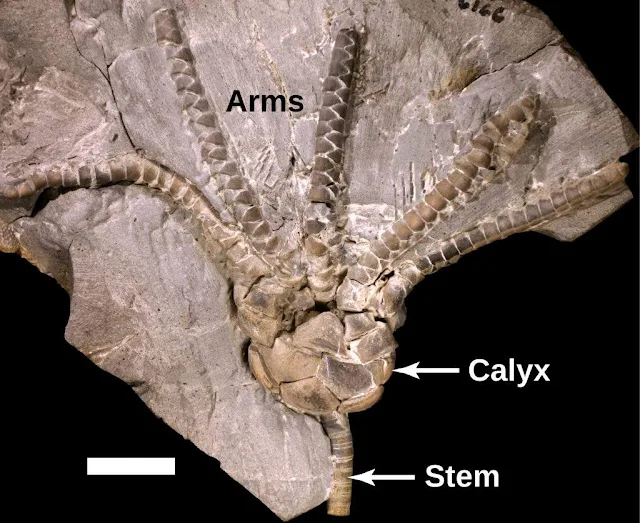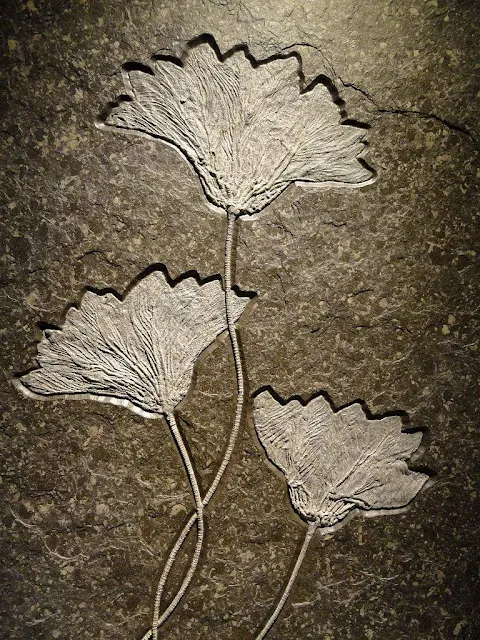Crinoids: The Fossils That Inspired 'Alien'
Crinoids are commonly known as sea lilies due to their "flower-like" appearance , though they are animals, not plants.
Crinoids are part of a large group of marine invertebrate animals called echinoderms. Other echinoderms are starfish, brittle stars, sand dollars, sea urchins, and sea cucumbers. All living echinoderms have what is called pentameral symmetry, which means their bodies are organized in patterns of five; for example, the five arms of the common starfish. Crinoids may have as few as five arms, but usually they have arms in multiples of five.
Crinoids derived in the Cambrian Period from pelmatozoan ancestors.
All echinoderms also have calcite plates (ossicles) embedded in their skin, which form their skeleton. That is why living starfish feel scratchy when you touch them. The skeletons of fossil crinoids are very representative of what the animals looked like a-live because only the outer skin layer is missing.
 |
| Crinoids: The Fossils That Inspired 'Alien'. Agaricocrinus americanus, crinoïde, carbonifère, Provenance: Indiana. |
Anatomy and Behavior of Crinoids
Structure:
Crinoids have a distinctive star-shaped or flower-like appearance. They consist of a cup-shaped body known as the calyx, which houses the vital organs, and a stalk or stem that attaches them to the ocean floor. Some species lack a stalk and are free-swimming.
Feeding Mechanism:
Crinoids are suspension feeders, using a series of feathery appendages called arms to capture small particles and plankton from the water. These arms are lined with tube feet that facilitate the movement of food particles toward the mouth at the center of the calyx.
 |
| Anatomy of a crinoid |
Types of Crinoid Fossils
Stem segments: These are the most common Crinoid fossils, often resembling beads or discs scattered across sedimentary rocks. They represent individual segments of the stalk, which anchored the crinoid to the seafloor.
Calices: These cup-shaped structures housed the crinoid's internal organs and feeding apparatus. Finding complete calices is rarer, but they offer valuable information about the species' anatomy and feeding strategies.
Crown: This refers to the entire upper portion of the crinoid, including the arms and calyx. Finding complete crowns is quite rare, but they provide the most comprehensive picture of the animal's morphology.
Complete crinoids: These rare fossils preserve the entire animal, offering a fascinating window into their overall morphology.
 |
| Fossils of Seirocrinus subsingularis from the Jurassic Holzmaden Black Shale Formation, Germany |
The largest Sea Lily has a large calyx which with its arms gives it a diametrer of 1.5 metres. The largest Feather star has an armspan of 35 cm. The smallest Crinoids are around 3 cm in diameter.
Most species are nocturnal filter feeders consuming plankton and decaying organic matter.
To feed they spread their feeding arms to sieve the passing sea water for microscopic organisms and detritus. Mucus, on the tube feet traps their food which is passed down the arms into the mouth by beating cilia. They have a U-shaped digestive system with the anus next to the mouth.
Not much is known about what eats them although fish and other Echinoderms (especially Sea urchins) are known predators. Sea lilies have been observed crawling away from Sea urchins.
Crinoids are either male or female with fertilization taking place in the water. The eggs hatch to form free-swimming larva which do not feed and settle on the bottom after a few days after which they metamorphise into an adult in 8 to 12 months. Some hatch as miniature adults, while some females even hold the eggs in their arms until they hatch.
The first true Crinoids appeared during the Lower Ordovician. Following the global mass extinction at the Silurian boundary, they and underwent several major radiations at the early Devonian, Missisippian (peak) and Pennsylvanian. They almost became extinct at the end of Paleozoic Era in the Permian, but recovered to flourish again during the Mesozoic, in the Triassic and Jurassic (Lias, Dogger, Malm). Decreasing numbers in the Cretaceaous, fossil record of crinoidsis rare in the Tertiary. More than 6,000 fossil species, belonging to more than 800 genera, have been described.
Today, approximately 600 living species are known; most free-living feather stars or comatulids living in the shallow seas. About 80 species of stalked sea lilies are restricted to the deeper water of today`s ocean.
Crinoids were very successful in the Paleozoic. They were most abundant and diverse in the Mississippian when several continents were covered with shallow seas. Thick layers of limestone stratigraphy throughout North America and Europe are full of crinoid stems.
Geological Significance
Crinoid fossils serve as important index fossils, aiding geologists in dating and correlating rock formations. Certain species of crinoids existed during specific time periods, making them useful for establishing the relative ages of sedimentary rocks.
Evolutionary insights:
Studying fossil crinoids across different
geological periods reveals their evolutionary changes and adaptations
over time.
Paleoenvironmental Indicators:
The presence of crinoid fossils in a rock formation can provide insights into the paleoenvironment of the ancient seas. Different species of crinoids inhabited varying water depths, and their fossils contribute to our understanding of past marine ecosystems.
Where to Find Crinoid Fossils
Crinoid fossils are widely distributed, found on all continents except Antarctica. Some notable locations include:
- North America: The Mississippian Valley, Great Plains, and Appalachian Mountains.
- Europe: The British Isles, Germany, and the Czech Republic.
- Asia: China, Japan, and Thailand.
- Africa: Morocco and South Africa.
Fossil hunting can be a rewarding hobby, but remember to collect responsibly and ethically, respecting regulations and conservation efforts.
Conclusion
Crinoid fossils offer a glimpse into the evolutionary history of these unique marine animals and the ecosystems they inhabited. Preserved in sedimentary rocks, these fossils not only contribute to our understanding of ancient seas but also serve as valuable tools for dating and correlating geological formations. The study of crinoid fossils continues to unravel the mysteries of Earth's distant past, enriching our knowledge of the planet's ever-changing landscapes.
See also:
The Largest Insect Ever Existed Was a Giant 'Dragonfly'
The Largest Ammonite Ever Found?
Remarkable 'Alien-Looking' Fossil Found in Australia






%20(1).webp)

